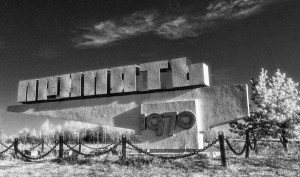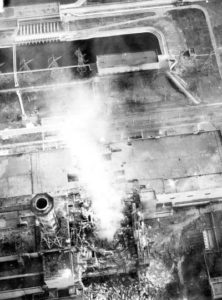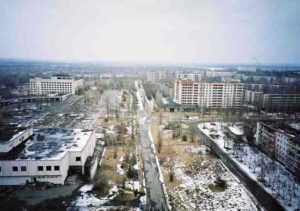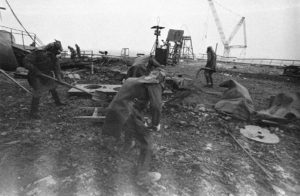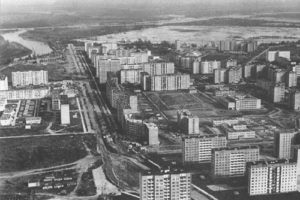It was during the early morning hours of April 26th, 1986. The governing bodies within the Soviet Union wanted to conduct another test of the backup power systems of one of it’s nuclear power plants; Namely, the the V.I. Lenin Nuclear Power Station, located near the city of Chernobyl, in the northern Ukraine. It was a simple test: See how much power the turbines of the power station could generate as the reactor shut down. The test was designed to simulate if there was a nuclear stike by the United States, meaning that the test would be conducted without the reactor systems being connected to external power. All they had was what power they could take from the slowing turbines, before the diesel backup systems would kick in.
However, due to flaws in the design of the RBMK reactor, disaster struck.
The RBMK (Reaktor Bolshoy Moshchnosti Kanalniy, “High Power Channel-type Reactor” ) system was designed to create weapons grade Plutonium, rather than only to generate electricity, like reactors in the Western world were used for. Because of this, the design was somewhat different, namely, the design of the control rods, and it’s use of normal water instead of Neutron absorbing “Heavy Water” .
The carbon based rods control the actual nuclear reaction in the core, absorbing neutrons and slowing down the reaction if inserted, or, if removed from the core, speeding up the reaction by allowing more neutrons to hit other atoms, generating more heat. This sounds simple enough, but the RBMK reactor systems had a deadly flaw in their control rods. During the test, the rods were slowly removed to generate as much heat possible to power the turbines, which would provide much needed electricity for the power station to monitor itself in the critical moments before the backup systems would activate. This planted the first seed to the disaster: steam.
As the reactor core heated, the water in its core changed to steam. Steam which would no longer behave the same as the liquid water did in moderating neutrons. The difference the normal or “light” water used in the core made was minimal in comparison to that that a heavy water based system would have, but it was still something calculated for in the design of the system. This loss of neutron moderating capacity lead to a massive chain reaction and overheating of the core. The workers at the plant did the logical step: they did an emergency insertion of the control rods to stop the reaction before the core material got hot enough to melt.
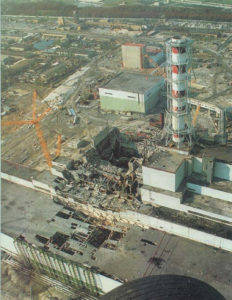
This is where the flaw in the control rods came into effect. The tips of the control rods were shaped in such a way as to actually displace coolant, resulting in an increase in reaction activity for short time before the rods would begin to properly do their job. This last spike in heat would be the last measurement recorded in the reactor before disaster struck. In a period of just under one minute, the reactor went from a contained power source, to the source of one of the worst nuclear disasters in human history.
A pair of explosions occurred within seconds of one another. The first was the core itself fracturing and beginning to melt under the extreme heat, and the second was a steam explosion caused by the superheated water in the reactor core. This completely destroyed the reactor, spreading much of its radioactive material into the upper atmosphere, and around the countryside for dozens of kilometers.
A nearby forest, now known as the Red Forst was killed by a cloud of radioactive dust, and would become one of the most contaminated places on the planet. The nearby city of Pripyat, built as a home to the workers of the plant, and their family, would 3 days later be evacuated of all 50,000 inhabitants, none of them to ever return to live at their homes. Dozens more villages in what is now the Exclusion zone would be evacuated of their inhabitants, and most would be demolished and buried due to contamination.
At the reactor site itself, for months, hundreds of people risked their lives walking into something they didn’t even understand. This was a time where the common Soviet citizen did not have proper knowledge on just how radiation worked, and these “liquidators” as they would be known, went into combat with the fires and debris of the reactor in sometimes nothing more than pants and a shirt, all the while receiving lethal doses of radiation, all in an effort to contain the hell that was Reactor 4. All in an effort to, in many ways, save the world.
In the months following the disaster, a steel shell known as the Sarcophagous, would be built around the remains of the reactor. The rest of the plant, Reactors 1, 2 and 3, would continue running until various conditions caused reactors 1 and 2 to be shut down, and finally, in 2000, reactor 3 would be shut down, bringing and end to the Chernobyl power plant being a generating facility.
Cancer rates near the disaster area, and all across Europe, have risen since the explosion. Many people from Pripyat suffer long term health problems from being so close to the disaster for 3 days. Even in animals, there have been high reports of mutations, illness, and various odd conditions.
These days, work is underway on a new containment structure. Pripyat is still abandoned, and there is still a 30 Kilometer exclusion zone surrounding the plant, where no one except for special plant-related personnel may live. The world has mostly forgotten about Chernobyl, but I think we should always remember it.
There are a thousand stories from that event that we will never get to hear. We should at least make sure future generations hear the story of the event itself, and know not to put too much faith in technology.
Additional reading:

